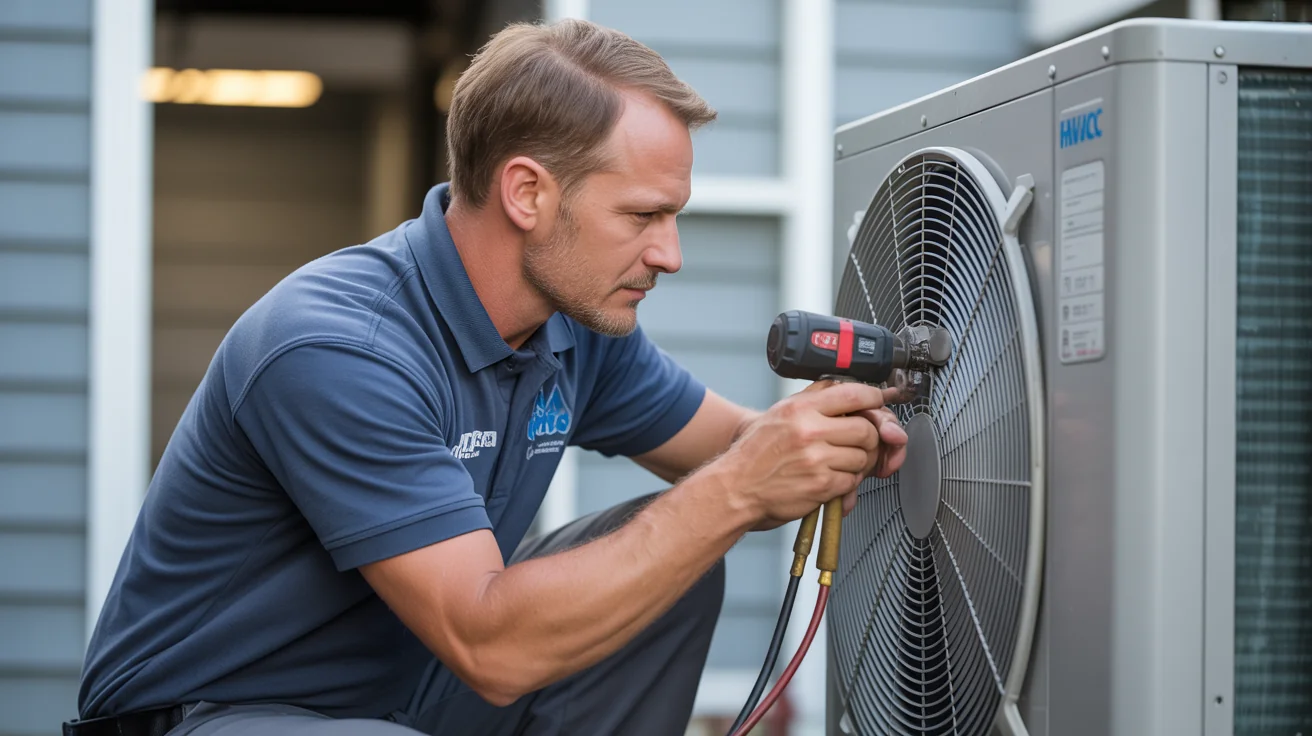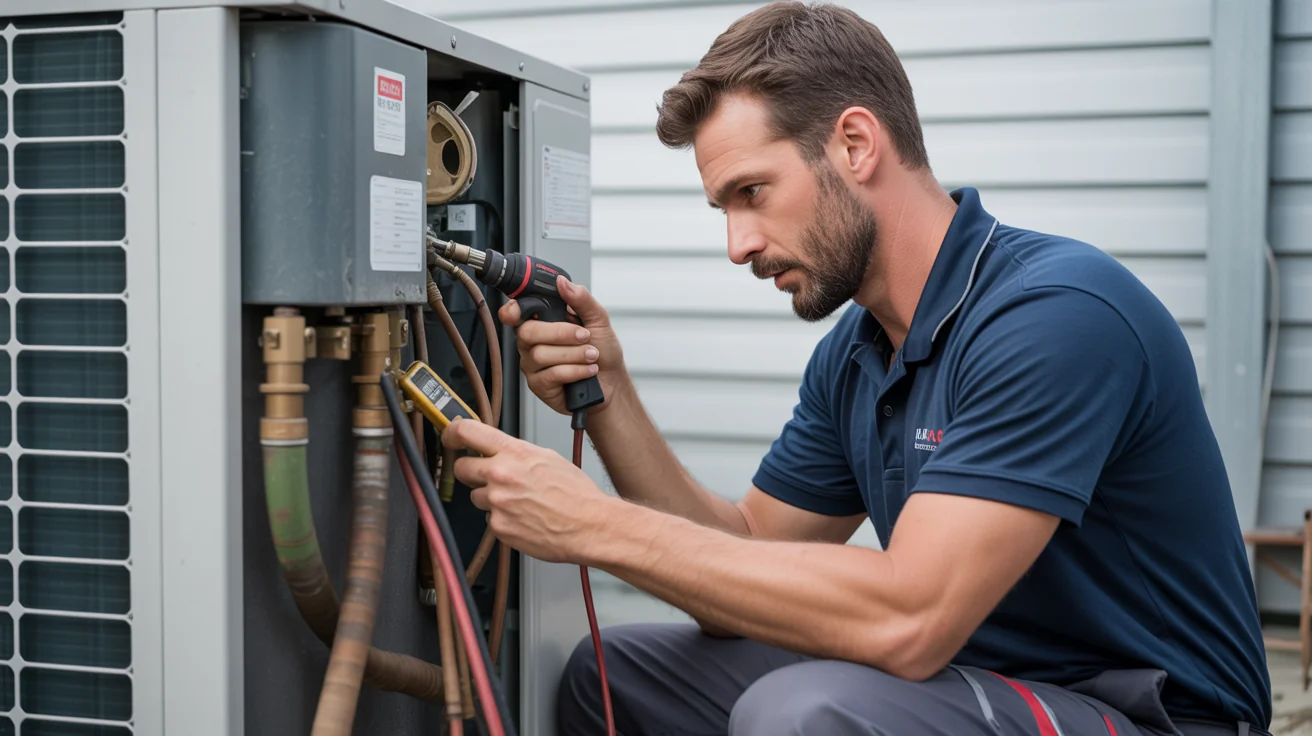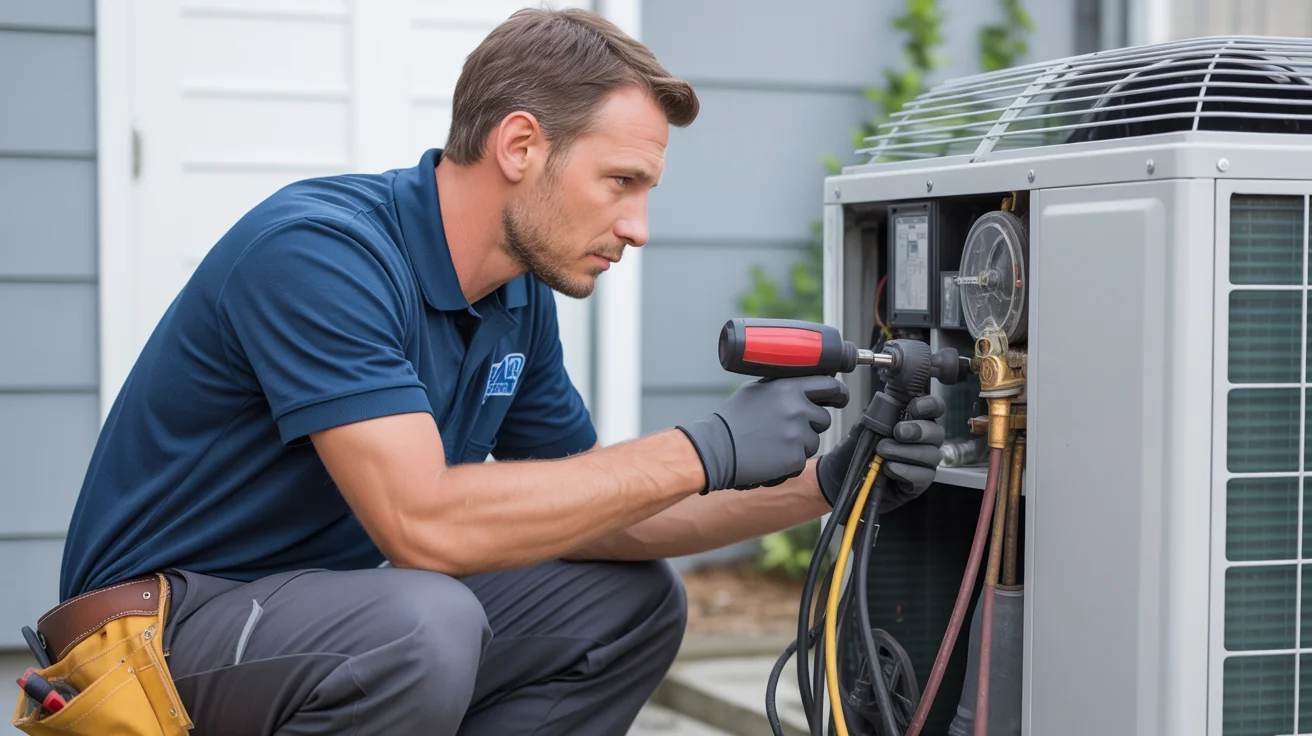Condenser Cleaning Safe Steps Your AC Needs This Now
That outdoor AC unit covered in dirt and cottonwood? Here's exactly how to clean it safely without destroying $2000 worth of fins. North Texas dust requires special handling.

- Your Condenser Looks Like It Lost a Fight With a Dust Storm
- Why North Texas Condensers Get Trashed So Fast
- Safety First (Or How Not to Electrocute Yourself)
- The Actual Cleaning Process That Won’t Destroy Your Unit
- Signs You’re In Over Your Head
- What Professional Cleaning Actually Includes
- The Maintenance Schedule Nobody Follows
- Common Mistakes That Cost Thousands
+ 3 more sections below...
- Your Condenser Looks Like It Lost a Fight With a Dust Storm
- Why North Texas Condensers Get Trashed So Fast
- Safety First (Or How Not to Electrocute Yourself)
- The Actual Cleaning Process That Won’t Destroy Your Unit
- Signs You’re In Over Your Head
- What Professional Cleaning Actually Includes
- The Maintenance Schedule Nobody Follows
- Common Mistakes That Cost Thousands
+ 3 more sections below...
Your Condenser Looks Like It Lost a Fight With a Dust Storm
Walked around the side of a house in West Frisco yesterday. The homeowner, nice guy named Dave, pointed at his AC condenser and said, “Is it supposed to look like that?”
No Dave. No it’s not.
His outdoor unit had this thick mat of cottonwood seeds, dust, and what I’m pretty sure was leftover grass clippings from 2023 all packed into the fins. The thing looked like someone glued a dirty carpet to it. His electric bill? Up $180 last month. The unit was working so hard to breathe through all that crud, it sounded like my uncle trying to climb stairs after Thanksgiving dinner.
Here’s the thing about condensers in North Texas - they take more abuse than anywhere else I’ve worked. Between our dust storms that roll through in April, the cottonwood apocalypse in May, and grass clippings flying around all summer, your outdoor unit basically becomes a giant air filter for your entire neighborhood.
I’ve cleaned condensers for 12 years now, and I still remember the first one I completely destroyed. Brand new tech, thought I knew everything. Hit those aluminum fins with a pressure washer at full blast. Bent every single one. The unit looked like someone took a baseball bat to it. Cost the company $2,100 to replace the coil. My boss made me stay late for a month filing paperwork. Lesson learned.
Call us at (940) 390-5676 if you want this done right the first time. But if you’re determined to tackle it yourself, at least let me show you how not to destroy your equipment.
Why North Texas Condensers Get Trashed So Fast
Last May, we had that dust storm roll through - the one that turned the sky orange for three hours? I had 47 service calls the next week. Every single condenser looked like it went through a flour factory explosion.
Your condenser sits outside 24/7/365. No protection. No shelter. Just sitting there taking whatever North Texas throws at it. And we throw a lot.
Those cottonwood trees everyone loves? Their fuzzy seeds create an inch-thick blanket on your coils by June. Add our 60 mph spring winds carrying construction dust from all the new developments between Frisco and Prosper, and you’ve got a recipe for a suffocated AC system.
Here’s what happens when you ignore it: Your unit can’t release heat properly. It’s like trying to cool your house while wearing a winter coat. The compressor runs longer, works harder, and pulls more amps. I measured one unit in Plano last week - it was pulling 23 amps when it should’ve been pulling 15. That’s your electric bill going through the roof.
Safety First (Or How Not to Electrocute Yourself)
Before you touch anything, let me tell you about Tom from Allen. Tom watched a YouTube video, grabbed his hose, and started spraying. What Tom didn’t do was turn off the power.
Water hit the electrical connections. Breaker tripped. Tom got lucky - just scared, not hurt. His control board? Fried. $650 mistake.
The Non-Negotiable Safety Steps:
1. TURN OFF THE POWER Walk to your breaker box. Find the breaker labeled “AC” or “Outside Unit.” Flip it OFF. Then go outside and look for a disconnect box near the unit (gray box on the wall). Pull the disconnect out completely.
I don’t care if your neighbor says it’s fine to leave it on. I don’t care if the YouTube guy did it with power on. Turn. It. Off.
2. Wait 30 Minutes Capacitors hold charge even after power’s off. Touch the wrong thing too soon, and you’ll know it. I learned this the hard way in 2014. Still have the scar on my thumb.
3. Never Use These Tools:
- Pressure washer (destroys fins instantly)
- Screwdriver or knife to scrape (punctures coils)
- Harsh chemicals like bleach (eats aluminum)
- Wire brush (scratches protective coating)
The Actual Cleaning Process That Won’t Destroy Your Unit
What You’ll Need:
- Garden hose with spray nozzle (NOT a pressure washer)
- Coil cleaner spray ($12 at Home Depot)
- Soft brush (old paintbrush works)
- Fin comb ($8 - get the one with multiple sizes)
- Shop vac
- Gloves and safety glasses
- Maybe a beer for afterward (you’ll be sweaty)
Step 1: Clear the Big Stuff (5 minutes)
Put on your gloves. Start pulling off the obvious stuff - leaves, cottonwood mats, grass clippings. That layer of fuzzy white cottonwood? Comes off in sheets if you’re gentle. Found a bird nest in one unit last month. Also found three tennis balls, a Frisbee, and what looked like half a mulch bag.
Use your hands, not tools. If it won’t come off easy, leave it for the spray.
Step 2: Vacuum the Fins (10 minutes)
Take your shop vac with the brush attachment. Gently run it over the fins from outside. You’re not trying to deep clean yet - just getting the loose stuff.
Go slow. Those fins bend if you look at them wrong. Bent fins block airflow just like dirt does.
Step 3: Apply Coil Cleaner (5 minutes)
Spray the coil cleaner on from outside, starting at the top. Let it foam up. This is where the magic happens - the foam pushes dirt out from between the fins.
Don’t cheap out here. The $3 bottle doesn’t do anything. Get the $12 foaming stuff. AC-Safe or Nu-Calgon work great. That Simple Green your wife uses in the kitchen? Leave it there.
Let it sit for 10 minutes. This is when I usually check my phone and realize I have 17 missed calls from other people with dirty condensers.
Step 4: Rinse From Inside Out (15 minutes)
Here’s where most people mess up. They blast from outside and push all the dirt deeper into the coils.
Open the top of the unit (usually 8-10 screws). Spray from INSIDE going OUT. Low pressure. Think “gentle spring rain,” not “hurricane simulator.”
Work in sections. Top to bottom. You’ll see brown water running out - that’s good. Keep going until it runs clear.
Step 5: Straighten Bent Fins (10 minutes)
Got bent fins? Use that fin comb. Gentle vertical strokes. Don’t try to get them perfect - 80% straight is good enough.
Skip this step if more than 25% of your fins are bent. You’ll make it worse. Call a pro at that point.
Step 6: Clean the Area (5 minutes)
Clear everything within 2 feet of the unit. Those decorative plants your wife put there? Move them. That mulch piled against the unit? Pull it back. The unit needs room to breathe.
I serviced a house in McKinney where they built a “decorative enclosure” around their condenser. Basically a wooden box with tiny air holes. Their electric bill was $600 in July. We tore it down. Bill dropped to $350.
Signs You’re In Over Your Head
Sometimes you need to put down the hose and pick up the phone. Call us at (940) 390-5676 if you see:
1. Refrigerant Lines Covered in Ice Stop immediately. You’ve got bigger problems than dirty coils.
2. Fins That Crumble When Touched Your coil is corroded. Cleaning won’t help. You need a new one.
3. Black Mold or Green Algae This needs professional antimicrobial treatment. Don’t breathe that stuff.
4. Bent Fins Over 50% of the Coil You’ll never straighten these yourself. We have special tools.
5. Oil Stains Around the Unit Refrigerant leak. You’re not fixing this with a garden hose.
6. You’re Scared of Breaking It Trust your gut. If you’re nervous, there’s probably a reason.
What Professional Cleaning Actually Includes
When we clean a condenser for $150-250, here’s what happens:
First, we test your amp draw and refrigerant pressures. Tells us if cleaning will actually help or if you have other issues.
We use commercial-grade coil cleaner and a special low-pressure sprayer. Not the garden hose special - actual equipment designed for aluminum fins.
We straighten fins with professional combs. Check electrical connections. Oil the fan motor. Test the capacitor. Check the contactor for pitting. Basically, we do 15 other things while we’re there.
Last week I cleaned a unit in West Plano. Dropped their amp draw from 21 to 14. Their July electric bill will be about $125 lower. The cleaning pays for itself in two months.
The Maintenance Schedule Nobody Follows
In a perfect world, you’d check your condenser monthly from April through October. In reality? Nobody does that.
Here’s what actually works:
After Dust Storms: Check within 48 hours. That dust turns to concrete when it gets wet.
May/June: The cottonwood apocalypse. Check weekly or just give up and call us.
After Mowing: Walk around and look. Takes 30 seconds. Grass clippings are condenser cancer.
October: Last cleaning before winter. Do it right and you’ll start next summer clean.
When Your Bill Jumps: If your electric bill goes up $50+ with no explanation, go look at your condenser. Bet you $20 it’s filthy.
Common Mistakes That Cost Thousands
The Pressure Washer Hero: “But I put it on low setting!” Doesn’t matter. I see three destroyed condensers every summer from pressure washers. Those fins are thinner than paper.
The Chemical Genius: Guy in Little Elm used oven cleaner because “it works great on tough grease.” Ate through his coils. $3,200 replacement.
The Fin Straightener Perfectionist: Spent three hours trying to straighten every single fin. Ended up breaking half of them off. Sometimes good enough really is good enough.
The Power-On Cleaner: “I was careful not to spray the electrical parts.” Famous last words. Water finds a way. Always finds a way.
North Texas Specific Problems
Construction Dust: All those new developments in Frisco and Prosper? That dirt has to go somewhere. Usually ends up on your condenser.
Agricultural Dust: When they harvest cotton west of here, we see a spike in dirty condensers within days. That fine dust gets into everything.
Cottonwood Trees: Pretty to look at. Absolute nightmare for AC units. One mature tree can blanket six houses’ condensers.
Our Weather Swings: 95°F one day, 45°F the next. The expansion and contraction loosens dirt, which then gets packed in tighter when it heats up again.
The Bottom Line
Your condenser takes a beating in North Texas. Between our dust, cottonwood, construction, and crazy weather, it needs regular attention or it’ll cost you hundreds in wasted electricity.
You can clean it yourself if you’re careful. Follow my steps, don’t use a pressure washer, and know when to quit. About $20-40 in supplies and an hour of sweat can save you real money.
But honestly? For $150-250, we’ll do it right, check everything else, and you don’t risk destroying $2,000 worth of equipment. Plus you stay cool inside while we sweat in your backyard.
We’re available 24/7 at (940) 390-5676. Yeah, even at 2 AM when you suddenly remember you haven’t cleaned your condenser since 2019 and can’t sleep because of the guilt. Though maybe just wait until morning for that one.
What’s Your Condenser Horror Story?
Seriously, I want to know. What’s the weirdest thing you’ve found stuck in your outdoor unit? Dead snake? Kid’s toys? That amazon package you couldn’t find?
Mine was a complete pepperoni pizza, still in the box. No idea how it got there. The homeowner swore he didn’t put it there. The pizza was three weeks old. The ants had moved in and established a whole civilization.
Your condenser’s probably not that bad. Probably.
Need Professional HVAC Service?
Our certified technicians are ready to help with any HVAC needs in North Texas




